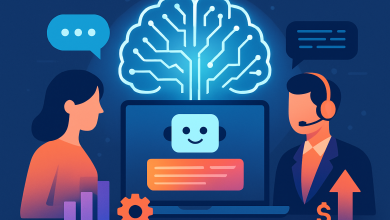Radiology analysis is rapidly evolving with AI and advanced machine learning (ML), which augment and substantially transform traditional manual interpretation, enabling intelligent pattern recognition, adaptive learning, and scalable decision support. These AI models, trained on large imaging datasets, accelerate image review, improve detection of subtle abnormalities, and reduce turnaround times, especially in urgent, high-volume settings. Integrated into clinical workflows, AI enhances diagnostic consistency and accuracy while easing routine tasks such as preliminary screening and report drafting. Additionally, AI enables real-time triage of critical conditions such as intracranial hemorrhages and strokes, supporting faster interventions and better patient outcomes.
AI-enabled Precision Diagnostics in Radiology
Conventional radiology imaging analyses have relied on radiologists manually interpreting scans such as X-rays, CTs, and MRIs. This process is inherently time-consuming (up to 6–8.5 hours/day) and subject to variability due to factors like fatigue, workload, and differences in clinical experience. Each stage of the manual workflow—from image acquisition to reporting—can introduce delays, further extending the time for diagnosis and treatment. Diagnostic accuracy may fluctuate, and in time-sensitive cases such as stroke or heart failure, these delays can significantly impact patient outcomes.
AI models, trained on large datasets of annotated medical images, are being used to automate parts of this imaging workflow. Unlike traditional rule-based systems, AI models can learn complex visual patterns and generalize across different imaging modalities. For example, Paige has developed a digital pathology system, Paige Prostate, that analyzes whole-slide images for prostate cancer. In certain settings, its diagnostic accuracy matches or exceeds that of pathologists while reducing the time needed for slide review.1 Similarly, Viz LVO’s stroke detection platform integrates with hospital Picture Archiving and Communication Systems (PACS) systems to automatically identify suspected large vessel occlusions in CT angiograms. This system has been shown to reduce time-to-treatment by more than 30 minutes,2 a significant improvement in acute stroke care.
Another example of a government body evaluating AI’s potential is the NHS-led EDITH trial (Early Detection using Information Technology in Health), a large-scale study involving nearly 700,000 women across 30 UK sites.3 The trial evaluates whether AI can safely support breast cancer screening by reducing the need for dual readings of mammograms. The goal is to determine if a single radiologist, aided by AI, can maintain diagnostic accuracy while managing more cases. This reflects a broader trend toward integrating AI into clinical workflows without removing expert oversight, ensuring safety and effectiveness in high-stakes diagnostic decisions.
These implementations demonstrate that AI can process large volumes of imaging data quickly and consistently, supporting clinicians by identifying areas of concern and generating structured, reviewable outputs. Its ability to adapt to subtle variations in imaging data, rather than relying on fixed diagnostic rules, offers a practical advantage in high-volume or time-sensitive settings.
From Data to Diagnosis: Big Data and Deep Learning in Radiology
AI in radiology imaging employs large-scale annotated imaging datasets in combination with ML and deep learning (DL) techniques to improve image interpretation, anomaly detection, and quantitative imaging. Traditional radiology relies on human expertise to visually assess scans, a process that is inherently variable and susceptible to fatigue, workload, and subjective judgment. In contrast, AI systems apply data-driven algorithms—particularly convolutional neural networks (CNNs), transformer models, and generative models—to automate and standardize key tasks in the diagnostic workflow.
- CNNs serve as the backbone of many AI applications, especially for feature extraction, image segmentation, and classification. These models learn spatial hierarchies from imaging modalities such as CT, MRI, and X-ray, enabling them to localize and characterize anatomical structures and abnormalities with high precision. Transformer-based models are used to interpret contextual information within medical data and are increasingly applied in tasks such as diagnostic report generation, where they convert structured image outputs into natural language summaries. Multimodal models integrate imaging data with structured clinical inputs such as electronic health records (EHRs), vital signs, or laboratory results, allowing for more comprehensive diagnostic outputs.
- Generative models, including Variational Autoencoders (VAEs), Generative Adversarial Networks (GANs), and diffusion models, are central to tasks beyond classification and detection. GANs consist of a generator and a discriminator network that can create synthetic medical images, useful for data augmentation, domain adaptation, or noise reduction. VAEs encode imaging data into low-dimensional latent spaces and reconstruct them, supporting anomaly detection by identifying deviations from learned normal distributions. Diffusion models, which progressively refine noisy images, are increasingly used for super-resolution imaging, enabling improved clarity from low-quality inputs.
These technologies are integrated into radiology workflows via deployment on cloud-based systems or hospital infrastructure, connected to PACS and radiology information system (RIS). Tools such as TensorFlow and PyTorch are used for model development, with Python as the primary programming language. Data preprocessing and augmentation may involve distributed systems like Apache Spark or Hadoop, especially when working with high-volume or high-resolution medical datasets. AI systems perform tasks such as tumor segmentation, lung nodule classification, and cross-modality image synthesis, and can generate preliminary diagnostic reports for clinician review. The combination of advanced models and integrated systems reduces variability and improves diagnostic efficiency, particularly in high-volume or time-sensitive clinical settings.
To translate AI-driven imaging gains into measurable revenue-cycle improvements, radiology practices should align clinical insights with administrative workflows. Pairing decision support with billing software in radiology helps standardize CPT/ICD coding from reports, automate pre-authorization and eligibility checks, accelerate clean-claim submission, and reduce denials through better documentation. When PACS/RIS, EHR, and billing systems are interoperable, teams can track turnaround times, case mix, and reimbursement trends, ensuring that efficiency advances at the workstation are realized as sustainable financial performance and compliance.
The Measurable Benefits of AI in Radiology
AI integration in radiology significantly improves both efficiency and diagnostic quality. A large-scale reader study involving 758 chest radiographs demonstrated that Gen AI reporting reduced average reading times by 42%, from 34.2 seconds to 19.8 seconds per image, while enhancing sensitivity for critical findings such as widened mediastinal silhouettes (improving from 84.3% to 90.8%) and pleural lesions (from 77.7% to 87.4%).4 Real-world clinical evaluations show a 15.5% increase in documentation efficiency, saving over 63 radiologist hours without compromising accuracy.5 In emergency settings, AI-supported triage enables real-time, accurate alerts for life-threatening conditions like intracranial hemorrhage, sometimes identifying cases initially missed by human readers, thus reducing errors and improving patient safety. While AI currently reaches accuracy comparable to non-expert clinicians (around 52%–57%), expert radiologists still outperform AI by 15%–16%, emphasizing AI’s role as an augmentation tool rather than a replacement in clinical workflows.
We have highlighted the key benefits of AI in radiology below, showcasing its impact on improving efficiency, diagnostic accuracy, and clinical workflow. These points reflect the substantial advancements supported by recent statistical and real-world evidence.
| Benefit Area | Description | Key Metrics & Statistical Data | Examples/Impact |
| Improved diagnostic precision | AI enhances accuracy and consistency in image interpretation by detecting subtle abnormalities often missed by humans. | – Reduction in false positives by up to 69%6 | AI detects early lung nodules, microfractures, and subtle hemorrhages with >90% accuracy in some applications7 |
| – Sensitivity for critical findings (e.g., mediastinal silhouette) improved by 5%–10%8 | Flagging nearly 50% of interval cancers missed by human readers9 | ||
| – Expert radiologists outperform AI by ~15%–16%10, indicating AI as an augmentation | Supports junior radiologists with real-time guidance and abnormality highlighting | ||
| Automated workflow management | AI automates routine and laborious image processing tasks, reduces turnaround times, and manages workflow bottlenecks. | – Interpretation/reporting time reduced by 17%–42%, e.g., chest radiographs reading time cut from ~34s to ~20s11 | Rapid triage in emergency cases (e.g., pneumothorax flagged for immediate attention). |
| – Over 63 radiologist hours saved across hospitals due to report automation12 | AI helps prioritize urgent cases, reducing treatment delays from days to hours. | ||
| – Improved reporting consistency across shifts and facilities | Remote radiologist support through AI-enabled tele-radiology services. | ||
| Enhanced detection of subtle pathologies | AI models trained on large datasets identify intricate patterns and subtle pathologies beyond human vision. | – Detection sensitivity improvements of 5%–10% for subtle findings13 | Rapid detection of intracranial hemorrhages previously missed by humans. |
| – Ability to handle large imaging volumes (hundreds to thousands of images per study) | Early cancer and neurological lesion detection improved via AI pattern recognition. | ||
| Quantitative imaging and biomarker discovery | AI extracts quantitative features and integrates multimodal data for precision diagnostics and personalized care. | – Integration of electronic health records (EHR) with imaging for holistic analysis | Radiomic feature extraction supports the prediction of disease progression and treatment response. |
| – Generative models improve image quality via denoising and super-resolution | Enhanced biomarker discovery through AI-led data fusion and analysis. | ||
| – Facilitates structured, natural language diagnostic reports aiding clinical decision-making | Multi-modal AI provides comprehensive patient summaries combining images and clinical data |
Proven Applications of AI in Radiology: Case Studies and Clinical Impact
AI is increasingly used in radiological analysis to accelerate image interpretation, enhance diagnostic accuracy, and streamline clinical workflows. As seen in the examples below, AI tools can analyze medical images such as X-rays, CT scans, and MRIs to detect abnormalities quickly and consistently, often flagging urgent cases for immediate review. This capability is especially impactful in time-sensitive conditions such as fractures, hemorrhages, or strokes, where reduced time to treatment can significantly improve outcomes. Additionally, AI supports tasks like report generation and quality assurance by highlighting subtle pathologies and minimizing diagnostic variability caused by fatigue or high workload. These applications are designed to integrate into existing clinical systems, enabling radiologists to maintain oversight while leveraging AI to increase efficiency and consistency in their diagnostic processes.
| Organization | AI Application Highlights | Key Outcomes/Features |
| Multimodal AI system analyzing CT, MRI, X-ray images for triaging critical findings such as intracranial hemorrhage and pulmonary embolism | Reduced turnaround times, improved emergency department efficiency, and real-time flagging of urgent cases | |
| Cloud-based deep learning platform offering Lung CT.AI for advanced imaging analysis, including 4D blood flow visualization | Up to 70% reduction14 in missed detections, enhanced visualization for diagnostics, and supports complex clinical decision-making | |
| AI-guided ultrasound interpretation and quality assessment tools, enabling accurate scans by non-specialists | Expands ultrasound accessibility, improves scan quality, and supports operator training and workflow efficiency | |
| Vendor-neutral AI marketplace and orchestration platform integrating over 175 AI applications from multiple vendors into radiology workflows | Single interface for viewing, editing, and monitoring AI results; FDA-cleared universal AI viewer; real-time AI performance tracking and human-in-the-loop oversight | |
| Deep learning algorithms speeding up radiologists’ reading and image analysis | Increases reading speed by ~21% without compromising diagnostic accuracy15, improving workflow efficiency | |
| AI tools, including Lunit INSIGHT for mammography and chest X-rays, to detect cancers and lung abnormalities | Enhances detection accuracy, especially in dense breast tissue, and improves radiologist sensitivity and consistency | |
| AI Chest X-ray suite providing autonomous reporting and real-time quality assurance with detection of 75 pathologies | Autonomous case handling rate of 80%, significant backlog reduction, and improved diagnostic consistency; a CE-certified tool deployed in multiple hospitals16 | |
| Deep learning digital pathology AI for detecting prostate, breast, and colorectal cancers using whole-slide images | FDA-approved system with sensitivity of ~97.4% and specificity of ~94.8%; improves pathologist accuracy and consistency in cancer detection17 | |
| Deep learning tools like qXR for rapid chest X-ray analysis, detecting lung nodules, tuberculosis, and other lung diseases | Robust sensitivity (~99%) supports early diagnosis and triage, and rapid image analysis within a minute18 | |
| Multimodal AI platforms integrating imaging with clinical data for triage, diagnosis, and personalized care enhancement | Improves workflow optimization, patient outcome tracking, and facilitates complex data fusion across hospital departments |
Conclusion
We anticipate AI will assist radiologists with routine tasks like triaging images, making preliminary interpretations, and drafting reports, allowing clinicians to concentrate on complex diagnoses and decisions. Rather than replacing radiologists, its optimal use lies in a “human-in-the-loop” model, where AI outputs are reviewed and confirmed by medical experts. AI will enhance efficiency and consistency by flagging potential abnormalities and generating initial findings, but all results are reviewed, validated, and contextualized by trained medical professionals. This collaborative approach ensures diagnostic accuracy, builds clinician trust, and addresses ethical and legal considerations surrounding automated decisions in healthcare. Furthermore, the integration of AI can improve workflow standardization, reduce diagnostic errors associated with fatigue or high volume, and enable radiologists to deliver timelier and patient-centered care.
Despite its benefits, integrating AI into radiology presents challenges. Many AI models require access to large, high-quality datasets, yet clinical data can be incomplete, biased, or siloed across systems. Additionally, a lack of transparency in how AI models reach their conclusions can make results difficult to interpret or trust. Concerns about patient privacy, data governance, and equitable access to AI tools also present ongoing barriers. Addressing these challenges will require collaboration among researchers, clinicians, and regulators, as well as advances in explainable AI, better data integration, and robust validation frameworks. The overarching objective is to integrate AI into radiology in a way that is both clinically effective and ethically sound, with the intention of augmenting, rather than replacing, human expertise.





